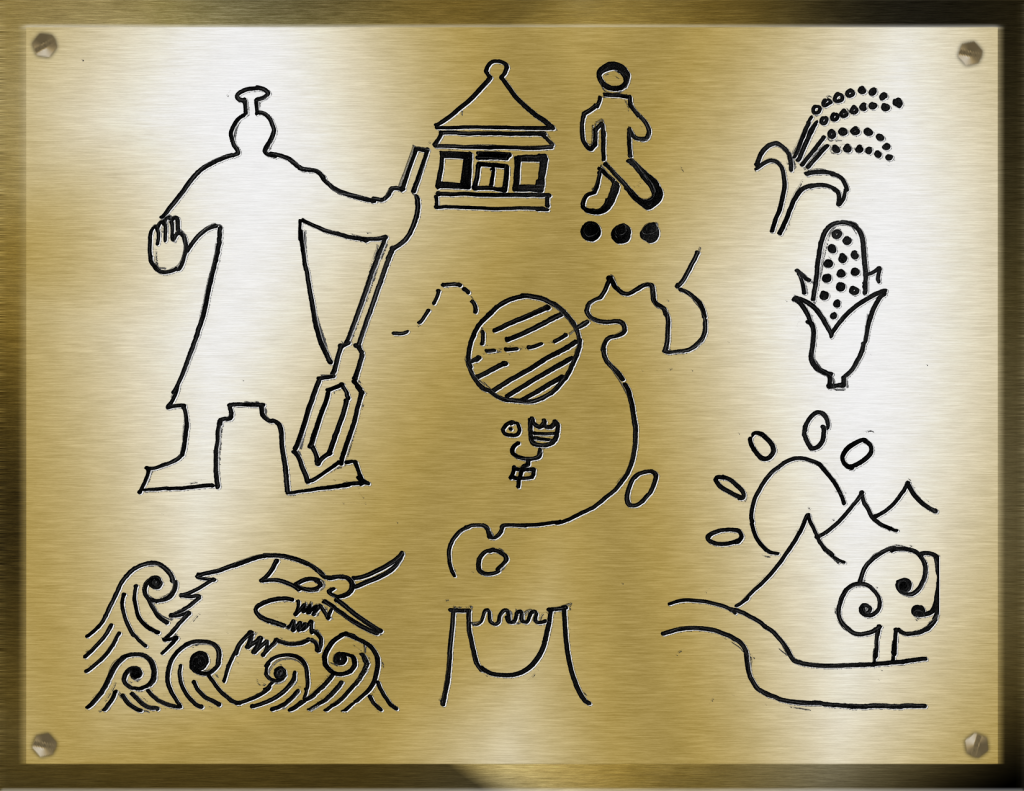
| Time Period | Ancient China, 2100 BCE) |
| Geographical Region | Northern China, along the Yellow River |
| List of Symbols |
|
This Golden Plaque is concerned with the story of Yu the Great. Yu the Great is the mythical sage king and founder of China’s first dynasty, the Xia Dynasty. The Xia Dynasty was located in Northern China on the Yellow River. The Yellow River earns it name from the high quantity of sediment and loess soil found its water, which gives it a yellowish tinge. Throughout Chinese history, the river could either bring the benefit of irrigation to the otherwise dry northern lands of China or it could bring death in the form of uncontrollable floods. Therefore, Chinese “water heroes” would appear every so often. These men were some of the few capable of transforming the river into a productive agriculture tool.
Yu the Great is the first of these Chinese water heroes. He is primarily known for his thirteen-year struggle to tame the Yellow River, which at the time was known for its chronic and unpredictable flooding. These floods would always result in great destruction to farmland. Chinese peasants who lived and worked these farms would either drown in the flood or would later die from starvation. In future dynasties, these displaced peasants would frequently form the core group for a rebellion. Yu’s significance in calming the Yellow River is symbolized by his outline on the left side of the plaque. With one hand, he commands the river and with the other, he holds a shovel, the tool which served him so well.
However, Yu the Great only conquered this river through prodigious diligence and effort. According to legend, during the thirteen years that Yu worked he never once stopped at home, choosing every time to pass by. The first time he walked by he heard the cries of his wife in labor giving birth to their son. The second time he passed by his home, he heard his son calling out his name. The third time, his son ran out of the house and greeted his father. Yu never once returned home until the river was tamed because he could not bear to think of all those who suffered while the river remained wild.
His battle and dedication became the model for his successors and the later Emperors of China who learned that only through their own constant vigilance would the river remain as Yu had made it. This story is denoted on the plaque by the outline of a man walking past his home. Underneath the man are three dots each signifying the number of times that Yu passed by his home and refused to go in, so that he could continue to work.
The transformation of the river under Yu’s guidance is shown by the following three symbols. These symbols, the dragon rising out of the water, the levee, and the calm river are meant to be read as a story of the river. The river that was once a wild a dragon, uncontrollable and fierce was overcome with manmade levees; thus, revealing serene scenery. In the last stage, the river is no longer the personification of the dangers of nature left unchecked. Under the watchful the eye of Yu, the Yellow River becomes beautiful as it supports human life as it can now be used to irrigate farms in a very dry part of the world.
The next two images found on the right hand side of the plaque show the crops that now can be grown in abundance along the Yellow River. Both rice and corn would have been grown to provide sustenance to those living in this area. Much later, crops of Western civilization such as potatoes and wheat would be added to the farmland of northern China. These two crops in particular would help enlarge the Chinese population even further due to their high caloric content.
The final image is a map of China which is found in the center of the plaque. The boundaries of the Xia Dynasty is indicated by the shaded area. Located below the shaded area is the ancient character that represented the Xia Dynasty. However, it should be noted that the boundaries of Xia Dynasty are not known perfectly as ancient records found on oracle bones are not clear on this account. Even still these boundaries are drawn according to historians’ best reckoning. The dotted line on the map signifies the Yellow River.
This plaque is designed to serve as reminder of Yu’s conquest of the Yellow River; it is meant to honor his achievement. However simultaneously it is warning. Without Yu’s great effort the Yellow River would remain untamed and without a similar level of care for the dikes and made construction the river once again will flow as it wishes.
ARTHUR BUSICK is a junior at the University, majoring in History with a focus in East Asian Studies. He is the president of his fraternity and a member of the NROTC program.
